Description
Warning
Not to be used during pregnancy as it can cause injury and even death to developing fetus.
Clinical particulars:
Therapeutic indications
Candesar is indicated for the:
- Treatment of essential hypertension in adults.
- Treatment of hypertension in children and adolescents aged 6 to <18 years.
- Treatment of adult patients with heart failure and impaired left ventricular systolic function (left ventricular ejection fraction ≤ 40%) when Angiotensin Converting Enzyme (ACE) inhibitors are not tolerated or as add-on therapy to ACE inhibitors in patients with symptomatic heart failure, despite optimal therapy, when mineralocorticoid receptor antagonists are not tolerated.
Posology and method of administration
Posology in Hypertension
The recommended initial dose and usual maintenance dose of Candesar is 8 mg once daily. Most of the antihypertensive effect is attained within 4 weeks. In some patients whose blood pressure is not adequately controlled, the dose can be increased to 16 mg once daily and to a maximum of 32 mg once daily. Therapy should be adjusted according to blood pressure response.
Candesar may also be administered with other antihypertensive agents.
Addition of hydrochlorothiazide has been shown to have an additive antihypertensive effect with various doses of Candesar.
Older people
No initial dose adjustment is necessary in elderly patients.
Patients with intravascular volume depletion
An initial dose of 4 mg may be considered in patients at risk for hypotension, such as patients with possible volume depletion.
Patients with renal impairment
The starting dose is 4 mg in patients with renal impairment, including patients on haemodialysis. The dose should be titrated according to response. There is limited experience in patients with very severe or end-stage renal impairment (Clcreatinine < 15 ml/min).
Patients with hepatic impairment
An initial dose of 4 mg once daily is recommended in patients with mild to moderate hepatic impairment. The dose may be adjusted according to response. Candesar is contraindicated in patients with severe hepatic impairment and/or cholestasis.
Black patients
The antihypertensive effect of candesartan is less pronounced in black patients than in non-black patients. Consequently, uptitration of Candesar and concomitant therapy may be more frequently needed for blood pressure control in black patients than in non-black patients.
Paediatric Population
Children and adolescents aged 6 to <18 years:
The recommended starting dose is 4 mg once daily.
- For patients weighing < 50 kg: In patients whose blood pressure is not adequately controlled, the dose can be increased to a maximum of 8 mg once daily.
- For patients weighing ≥ 50 kg: In patients whose blood pressure is not adequately controlled, the dose can be increased to 8 mg once daily and then to 16 mg once daily if needed.
Doses above 32 mg have not been studied in paediatric patients.
Most of the antihypertensive effect is attained within 4 weeks.
For children with possible intravascular volume depletion (e.g., patients treated with diuretics, particularly those with impaired renal function), Candesar treatment should be initiated under close medical supervision and a lower starting dose than the general starting dose above should be considered.
Candesar has not been studied in children with glomerular filtration rate less than 30 ml/min/1.73m2.
Black paediatric patients
The antihypertensive effect of candesartan is less pronounced in black patients than in non-black patients.
Children aged below 1 year to <6 years
The safety and efficacy in children aged 1 to <6 years of age has not been established. Currently available data are described in section 5.1 but no recommendation on a posology can be made.
Candesar is contraindicated in children aged below 1 year.
Posology in Heart Failure
The usual recommended initial dose of Candesar is 4 mg once daily. Up-titration to the target dose of 32 mg once daily (maximum dose) or the highest tolerated dose is done by doubling the dose at intervals of at least 2 weeks. Evaluation of patients with heart failure should always comprise assessment of renal function including monitoring of serum creatinine and potassium. Candesar can be administered with other heart failure treatment, including ACE inhibitors, beta-blockers, diuretics and digitalis or a combination of these medicinal products. Candesar may be co-administered with an ACE-inhibitor in patients with symptomatic heart failure despite optimal standard heart failure therapy when mineralocorticoid receptor antagonists are not tolerated.. The combination of an ACE inhibitor, a potassium-sparing diuretic (e.g. spironolactone) and Candesar is not recommended and should be considered only after careful evaluation of the potential benefits and risks.
Special patient populations
No initial dose adjustment is necessary for elderly patients or in patients with intravascular volume depletion or renal impairment or mild to moderate hepatic impairment.
Paediatric Population
The safety and efficacy of Candesar in children aged between birth and 18 years have not been established in the treatment of heart failure. No data are available.
Method of administration
Oral use.
Candesar should be taken once daily with or without food.
The bioavailability of candesartan is not affected by food.
Contraindications:
Hypersensitivity to candesartan cilexetil or to any of the excipients.
Second and third trimesters of pregnancy.
Severe hepatic impairment and/or cholestasis.
Children aged below 1 year.
The concomitant use of Candesar with aliskiren-containing products is contraindicated in patients with diabetes mellitus or renal impairment (GFR< 60ml/min/1.73m2).
Special warnings and precautions for use
Dual blockade of the renin-angiotensin-aldosterone system (RAAS)
There is evidence that the concomitant use of ACE inhibitors, angiotensin II receptor blockers or aliskiren increases the risk of hypotension, hyperkalaemia and decreased renal function (including acute renal failure). Dual blockade of RAAS through the combined use of ACE-inhibitors, angiotensin II receptor blockers or aliskiren is therefore not recommended.
If dual blockade therapy is considered absolutely necessary, this should only occur under specialist supervision and subject to frequent close monitoring of renal function, electrolytes and blood pressure. ACE-inhibitors and angiotensin II receptor blockers should not be used concomitantly in patients with diabetic nephropathy.
Renal impairment
As with other agents inhibiting the renin-angiotensin-aldosterone system, changes in renal function may be anticipated in susceptible patients treated with Candesar.
When Candesar is used in hypertensive patients with renal impairment, periodic monitoring of serum potassium and creatinine levels is recommended. There is limited experience in patients with very severe or end-stage renal impairment (Clcreatinine < 15 ml/min). In these patients Candesar should be carefully titrated with thorough monitoring of blood pressure.
Evaluation of patients with heart failure should include periodic assessments of renal function, especially in elderly patients 75 years or older, and patients with impaired renal function. During dose titration of Candesar, monitoring of serum creatinine and potassium is recommended. Clinical trials in heart failure did not include patients with serum creatinine > 265 μmol/l (> 3 mg/dl).
Use in paediatric patients including patients with renal impairment
Candesar has not been studied in children with a glomerular filtration rate less than 30 ml/min/1.73m2.
Concomitant therapy with an ACE inhibitor in heart failure
The risk of adverse reactions, especially hypotension, hyperkalaemia and decreased renal function (including acute renal failure), may increase when Candesar is used in combination with an ACE inhibitor. Triple combination of an ACE-inhibitor, a mineralocorticoid receptor antagonist and candesartan cilexetil is also not recommended. Use of these combinations should be under specialist supervision and subject to frequent close monitoring of renal function, electrolytes and blood pressure.
ACE-inhibitors and angiotensin II receptor blockers should not be used concomitantly in patients with diabetic nephropathy.
Haemodialysis
During dialysis the blood pressure may be particularly sensitive to AT1-receptor blockade as a result of reduced plasma volume and activation of the renin-angiotensin-aldosterone system. Therefore, Candesar should be carefully titrated with thorough monitoring of blood pressure in patients on haemodialysis.
Renal artery stenosis
Medicinal products that affect the renin-angiotensin-aldosterone system, including angiotensin II receptor antagonists (AIIRAs), may increase blood urea and serum creatinine in patients with bilateral renal artery stenosis or stenosis of the artery to a solitary kidney.
Kidney transplantation
There is no experience regarding the administration of Candesar in patients with recent kidney transplantation.
Hypotension
Hypotension may occur during treatment with Candesar in heart failure patients. It may also occur in hypertensive patients with intravascular volume depletion such as those receiving high dose diuretics. Caution should be observed when initiating therapy and correction of hypovolemia should be attempted.
For children with possible intravascular volume depletion (e.g. patients treated with diuretics, particularly those with impaired renal function), candesartan treatment should be initiated under close medical supervision and a lower starting dose should be considered.
Anaesthesia and surgery
Hypotension may occur during anaesthesia and surgery in patients treated with angiotensin II antagonists due to blockade of the renin-angiotensin system. Very rarely, hypotension may be severe such that it may warrant the use of intravenous fluids and/or vasopressors.
Aortic and mitral valve stenosis (obstructive hypertrophic cardiomyopathy)
As with other vasodilators, special caution is indicated in patients suffering from haemodynamically relevant aortic or mitral valve stenosis, or obstructive hypertrophic cardiomyopathy.
Primary hyperaldosteronism
Patients with primary hyperaldosteronism will not generally respond to antihypertensive medicinal products acting through inhibition of the renin-angiotensin-aldosterone system. Therefore, the use of Candesar is not recommended in this population.
Hyperkalaemia
Concomitant use of Candesar with potassium-sparing diuretics, potassium supplements, salt substitutes containing potassium, or other medicinal products that may increase potassium levels (e.g. heparin) may lead to increases in serum potassium in hypertensive patients. Monitoring of potassium should be undertaken as appropriate.
In heart failure patients treated with Candesar, hyperkalaemia may occur. Periodic monitoring of serum potassium is recommended. The combination of an ACE inhibitor, a potassium-sparing diuretic (e.g. spironolactone) and Candesar is not recommended and should be considered only after careful evaluation of the potential benefits and risks.
General
In patients whose vascular tone and renal function depend predominantly on the activity of the renin-angiotensin-aldosterone system (e.g. patients with severe congestive heart failure or underlying renal disease, including renal artery stenosis), treatment with other medicinal products that affect this system has been associated with acute hypotension, azotaemia, oliguria or, rarely, acute renal failure. The possibility of similar effects cannot be excluded with AIIRAs. As with any antihypertensive agent, excessive blood pressure decrease in patients with ischaemic cardiopathy or ischaemic cerebrovascular disease could result in a myocardial infarction or stroke.
The antihypertensive effect of candesartan may be enhanced by other medicinal products with blood pressure lowering properties, whether prescribed as an antihypertensive or prescribed for other indications.
Candesar contains lactose. Patients with rare hereditary problems of galactose intolerance, the Lapp lactase deficiency or glucose-galactose malabsorption should not take this medicinal product.
Pregnancy
AIIRAs should not be initiated during pregnancy. Unless continued AIIRA therapy is considered essential, patients planning pregnancy should be changed to alternative antihypertensive treatments which have an established safety profile for use in pregnancy. When pregnancy is diagnosed, treatment with AIIRAs should be stopped immediately, and, if appropriate, alternative therapy should be started.
In post-menarche patients the possibility of pregnancy should be evaluated on a regular basis. Appropriate information should be given and/or action taken to prevent the risk of exposure during pregnancy.
Interaction with other medicinal products and other forms of interaction
Compounds which have been investigated in clinical pharmacokinetic studies include hydrochlorothiazide, warfarin, digoxin, oral contraceptives (i.e. ethinylestradiol/levonorgestrel), glibenclamide, nifedipine and enalapril. No clinically significant pharmacokinetic interactions with these medicinal products have been identified.
Concomitant use of potassium-sparing diuretics, potassium supplements, salt substitutes containing potassium, or other medicinal products (e.g. heparin) may increase potassium levels. Monitoring of potassium should be undertaken as appropriate.
Reversible increases in serum lithium concentrations and toxicity have been reported during concomitant administration of lithium with ACE inhibitors. A similar effect may occur with AIIRAs. Use of candesartan with lithium is not recommended. If the combination proves necessary, careful monitoring of serum lithium levels is recommended.
When AIIRAs are administered simultaneously with non-steroidal anti-inflammatory drugs (NSAIDs) (i.e. selective COX-2 inhibitors, acetylsalicylic acid (> 3 g/day) and non-selective NSAIDs), attenuation of the antihypertensive effect may occur.
As with ACE inhibitors, concomitant use of AIIRAs and NSAIDs may lead to an increased risk of worsening of renal function, including possible acute renal failure, and an increase in serum potassium, especially in patients with poor pre-existing renal function. The combination should be administered with caution, especially in the elderly. Patients should be adequately hydrated and consideration should be given to monitoring renal function after initiation of concomitant therapy, and periodically thereafter.
Clinical trial data has shown that dual blockade of the renin-angiotensin-aldosterone-system (RAAS) through the combined use of ACE-inhibitors, angiotensin II receptor blockers or aliskiren is associated with a higher frequency of adverse events such as hypotension, hyperkalaemia and decreased renal function (including acute renal failure) compared to the use of a single RAAS-acting agent.
Paediatric population
Interaction studies have only been performed in adults
Fertility, pregnancy and lactation
Pregnancy
Epidemiological evidence regarding the risk of teratogenicity following exposure to ACE inhibitors during the first trimester of pregnancy has not been conclusive; however a small increase in risk cannot be excluded. Whilst there is no controlled epidemiological data on the risk with AIIRAs, similar risks may exist for this class of drugs. Unless continued AIIRA therapy is considered essential, patients planning pregnancy should be changed to alternative antihypertensive treatments which have an established safety profile for use in pregnancy. When pregnancy is diagnosed, treatment with AIIRAs should be stopped immediately and, if appropriate, alternative therapy should be started.
Exposure to AIIRA therapy during the second and third trimesters is known to induce human fetotoxicity (decreased renal function, oligohydramnios, skull ossification retardation) and neonatal toxicity (renal failure, hypotension, hyperkalaemia).
Should exposure to AIIRAs have occurred from the second trimester of pregnancy, ultrasound check of renal function and skull is recommended.
Infants whose mothers have taken AIIRAs should be closely observed for hypotension.
Breastfeeding
Because no information is available regarding the use of Candesar during breastfeeding, Candesar is not recommended and alternative treatments with better established safety profiles during breast-feeding are preferable, especially while nursing a newborn or preterm infant.
Effects on ability to drive and use machines
No studies on the effects of candesartan on the ability to drive and use machines have been performed. However, it should be taken into account that occasionally dizziness or weariness may occur during treatment with Candesar.
Undesirable effects
Treatment of Hypertension
In controlled clinical studies adverse reactions were mild and transient. The overall incidence of adverse events showed no association with dose or age. Withdrawals from treatment due to adverse events were similar with candesartan cilexetil (3.1%) and placebo (3.2%).
In a pooled analysis of clinical trial data of hypertensive patients, adverse reactions with candesartan cilexetil were defined based on an incidence of adverse events with candesartan cilexetil at least 1% higher than the incidence seen with placebo. By this definition, the most commonly reported adverse reactions were dizziness/vertigo, headache and respiratory infection.
The table below presents adverse reactions from clinical trials and post-marketing experience.
The frequencies used in the tables throughout section 4.8 are: very common (≥ 1/10), common (≥ 1/100 to < 1/10), uncommon (≥ 1/1,000 to < 1/100), rare (≥ 1/10,000 to < 1/1,000) and very rare (< 1/10,000).
| System Organ Class | Frequency | Undesirable Effect |
| Infections and infestations | Common | Respiratory infection |
| Blood and lymphatic system disorders | Very rare | Leukopenia, neutropenia and agranulocytosis |
| Metabolism and nutrition disorders | Very rare | Hyperkalaemia, hyponatraemia |
| Nervous system disorders | Common | Dizziness/vertigo, headache |
| Respiratory, thoracic and mediastinal disorders | Very rare | Cough |
| Gastrointestinal disorders | Very rare | Nausea |
| Hepato-biliary disorders | Very rare | Increased liver enzymes, abnormal hepatic function or hepatitis |
| Skin and subcutaneous tissue disorders | Very rare | Angioedema, rash, urticaria, pruritus |
| Musculoskeletal and connective tissue disorders | Very rare | Back pain, arthralgia, myalgia |
| Renal and urinary disorders | Very rare | Renal impairment, including renal failure in susceptible patients |
Laboratory findings
In general, there were no clinically important influences of Candesartan on routine laboratory variables. As for other inhibitors of the renin-angiotensin-aldosterone system, small decreases in haemoglobin have been seen. No routine monitoring of laboratory variables is usually necessary for patients receiving Candesartan. However, in patients with renal impairment, periodic monitoring of serum potassium and creatinine levels is recommended.
Paediatric population
The safety of candesartan cilexetil was monitored in 255 hypertensive children and adolescents, aged 6 to <18 years old, during a 4 week clinical efficacy study and a 1 year open label study. In nearly all different system organ classes, the frequency of adverse events in children are within common/uncommon range. Whilst the nature and severity of the adverse events are similar to those in adults (see the table above), the frequency of all adverse events are higher in children and adolescent, particularly in:
- Headache, dizziness and upper respiratory tract infection, are “very common” (ie, ≥1/10) in children and common (≥ 1/100 to < 1/10) in adults.
- Cough is “very common” (ie, > 1/10) in children and very rare (<1/10,000) in adults.
- Rash is “common” (ie, ≥1/100 to <1/10) in children and “very rare” (<1/10,000) in adults.
- Hyperkalemia, hyponatraemia and abnormal liver function are uncommon (≥ 1/1,000 to < 1/100) in children and very rare (< 1/10,000) in adults.
- Sinus arrhythmia, Nasopharyngitis, pyrexia are “common” (ie, ≥1/100 to <1/10) and oropharyngeal pain is “very common” (ie, ≥1/10) in children; but none are reported in adults. However these are temporary and widespread childhood illnesses.
The overall safety profile for candesartan cilexetil in paediatric patients does not differ significantly from the safety profile in adults.
Treatment of Heart Failure
The adverse experience profile of candesartan in adult heart failure patients was consistent with the pharmacology of the drug and the health status of the patients. In the CHARM clinical programme, comparing candesartan in doses up to 32 mg (n=3,803) to placebo (n=3,796), 21.0% of the candesartan cilexetil group and 16.1% of the placebo group discontinued treatment because of adverse events. The most commonly reported adverse reactions were hyperkalaemia, hypotension and renal impairment. These events were more common in patients over 70 years of age, diabetics, or subjects who received other medicinal products which affect the renin-angiotensin-aldosterone system, in particular an ACE inhibitor and/or spironolactone.
The table below presents adverse reactions from clinical trials and post-marketing experience.
| System Organ Class | Frequency | Undesirable Effect |
| Blood and lymphatic system disorders | Very rare | Leukopenia, neutropenia and agranulocytosis |
| Metabolism and nutrition disorders | Common | Hyperkalaemia |
| Very rare | Hyponatraemia | |
| Nervous system disorders | Very rare | Dizziness, headache |
| Vascular disorders | Common | Hypotension |
| Respiratory, thoracic and mediastinal disorders | Very rare | Cough |
| Gastrointestinal disorders | Very rare | Nausea |
| Hepato-biliary disorders | Very rare | Increased liver enzymes, abnormal hepatic function or hepatitis |
| Skin and subcutaneous tissue disorders | Very rare | Angioedema, rash, urticaria, pruritus |
| Musculoskeletal and connective tissue disorders | Very rare | Back pain, arthralgia, myalgia |
| Renal and urinary disorders | Common | Renal impairment, including renal failure in susceptible patients |
Laboratory findings
Hyperkalaemia and renal impairment are common in patients treated with candesartan for the indication of heart failure. Periodic monitoring of serum creatinine and potassium is recommended.
Reporting of suspected adverse reactions
Reporting suspected adverse reactions after authorisation of the medicinal product is important. It allows continued monitoring of the benefit/risk balance of the medicinal product. Healthcare professionals are asked to report any suspected adverse reactions.
Overdose
Symptoms
Based on pharmacological considerations, the main manifestation of an overdose is likely to be symptomatic hypotension and dizziness. In individual case reports of overdose (of up to 672 mg candesartan cilexetil) in an adult, patient recovery was uneventful.
Management
If symptomatic hypotension should occur, symptomatic treatment should be instituted and vital signs monitored. The patient should be placed supine with the legs elevated. If this is not sufficient, plasma volume should be increased by infusion of, for example, isotonic saline solution. Sympathomimetic medicinal products may be administered if the above-mentioned measures are not sufficient.
Candesartan is not removed by haemodialysis.
Pharmacological properties
Pharmacodynamic properties
Pharmacotherapeutic group:
Angiotensin II antagonists, plain,
Mechanism of action
Angiotensin II is the primary vasoactive hormone of the renin-angiotensin-aldosterone system and plays a role in the pathophysiology of hypertension, heart failure and other cardiovascular disorders. It also has a role in the pathogenesis of end organ hypertrophy and damage. The major physiological effects of angiotensin II, such as vasoconstriction, aldosterone stimulation, regulation of salt and water homeostasis and stimulation of cell growth, are mediated via the type 1 (AT1) receptor.
Pharmacodynamic effects
Candesartan cilexetil is a prodrug suitable for oral use. It is rapidly converted to the active substance, candesartan, by ester hydrolysis during absorption from the gastrointestinal tract. Candesartan is an AIIRA, selective for AT1 receptors, with tight binding to and slow dissociation from the receptor. It has no agonist activity.
Candesartan does not inhibit ACE, which converts angiotensin I to angiotensin II and degrades bradykinin. There is no effect on ACE and no potentiation of bradykinin or substance P. In controlled clinical trials comparing candesartan with ACE inhibitors, the incidence of cough was lower in patients receiving candesartan cilexetil. Candesartan does not bind to or block other hormone receptors or ion channels known to be important in cardiovascular regulation. The antagonism of the angiotensin II (AT1) receptors results in dose related increases in plasma renin levels, angiotensin I and angiotensin II levels, and a decrease in plasma aldosterone concentration.
Clinical efficacy and safety
Hypertension
In hypertension, candesartan causes a dose-dependent, long-lasting reduction in arterial blood pressure. The antihypertensive action is due to decreased systemic peripheral resistance, without reflex increase in heart rate. There is no indication of serious or exaggerated first dose hypotension or rebound effect after cessation of treatment.
After administration of a single dose of candesartan cilexetil, onset of antihypertensive effect generally occurs within 2 hours. With continuous treatment, most of the reduction in blood pressure with any dose is generally attained within four weeks and is sustained during long-term treatment. According to a meta-analysis, the average additional effect of a dose increase from 16 mg to 32 mg once daily was small. Taking into account the inter-individual variability, a more than average effect can be expected in some patients. Candesartan cilexetil once daily provides effective and smooth blood pressure reduction over 24 hours, with little difference between maximum and trough effects during the dosing interval.
The beneficial effects of candesartan were consistent irrespective of age, gender and concomitant medication. Candesartan was effective also in patients taking both beta-blockers and ACE inhibitors at the same time, and the benefit was obtained whether or not patients were taking ACE inhibitors at the target dose recommended by treatment guidelines.
In patients with CHF and depressed left ventricular systolic function (left ventricular ejection fraction, LVEF ≤ 40%), candesartan decreases systemic vascular resistance and pulmonary capillary wedge pressure, increases plasma renin activity and angiotensin II concentration, and decreases aldosterone levels.
Heart failure treatment with candesartan reduces mentality, hospitalization due to heart failure and improves symptoms in patient with left ventricular systolic dysfunction.
Pharmacokinetic properties
Absorption and distribution
Following oral administration, candesartan cilexetil is converted to the active substance candesartan. The absolute bioavailability of candesartan is approximately 40% after an oral solution of candesartan cilexetil. The relative bioavailability of the tablet formulation compared with the same oral solution is approximately 34% with very little variability. The estimated absolute bioavailability of the tablet is therefore 14%. The mean peak serum concentration (Cmax) is reached 3to4 hours following tablet intake. The candesartan serum concentrations increase linearly with increasing doses in the therapeutic dose range. No gender related differences in the pharmacokinetics of candesartan have been observed. The area under the serum concentration versus time curve (AUC) of candesartan is not significantly affected by food.
Candesartan is highly bound to plasma protein (more than 99%). The apparent volume of distribution of candesartan is 0.1 l/kg.
The bioavailability of candesartan is not affected by food.
Biotransformation and elimination
Candesartan is mainly eliminated unchanged via urine and bile and only to a minor extent eliminated by hepatic metabolism (CYP2C9). Available interaction studies indicate no effect on CYP2C9 and CYP3A4. Based on in vitro data, no interaction would be expected to occur in vivo with drugs whose metabolism is dependent upon cytochrome P450 isoenzymes CYP1A2, CYP2A6, CYP2C9, CYP2C19, CYP2D6, CYP2E1 or CYP3A4. The terminal half-life of candesartan is approximately 9 hours. There is no accumulation following multiple doses.
Total plasma clearance of candesartan is about 0.37 ml/min/kg, with a renal clearance of about 0.19 ml/min/kg. The renal elimination of candesartan is both by glomerular filtration and active tubular secretion. Following an oral dose of 14C-labelled candesartan cilexetil, approximately 26% of the dose is excreted in the urine as candesartan and 7% as an inactive metabolite while approximately 56% of the dose is recovered in the faeces as candesartan and 10% as the inactive metabolite.
Pharmacokinetics in special populations
In the elderly (over 65 years) Cmax and AUC of candesartan are increased by approximately 50% and 80%, respectively in comparison to young subjects. However, the blood pressure response and the incidence of adverse events are similar after a given dose of Candesar in young and elderly patients.
In patients with mild to moderate renal impairment Cmax and AUC of candesartan increased during repeated dosing by approximately 50% and 70%, respectively, but t½ was not altered, compared to patients with normal renal function. The corresponding changes in patients with severe renal impairment were approximately 50% and 110%, respectively. The terminal t½ of candesartan was approximately doubled in patients with severe renal impairment. The AUC of candesartan in patients undergoing haemodialysis was similar to that in patients with severe renal impairment.
In two studies, both including patients with mild to moderate hepatic impairment, there was an increase in the mean AUC of candesartan of approximately 20% in one study and 80% in the other study. There is no experience in patients with severe hepatic impairment.
Paediatric population
The Pharmacokinetic properties of candesartan were evaluated in hypertensive children aged 1 to <6 years and 6 to <17 years in two single dose PK studies.
In children aged 1 to <6 years, 10 children weighing 10 to <25 kg received a single dose of 0.2 mg/kg, oral suspension. There was no correlation between Cmax and AUC with age or weight. No clearance data has been collected; therefore the possibility of a correlation between clearance and weight/age in this population is unknown.
In children aged 6 to <17 years, 22 children received a single dose of 16 mg tablet. There was no correlation between Cmax and AUC with age. However weight seems to significantly correlate with Cmax (p=0.012) and AUC (p=0.011). No clearance data, has been collected, therefore the possibility of a correlation between clearance and weight/age in this population is unknown.
Children >6 years of age had exposure similar to adults given the same dose.
The pharmacokinetics of candesartan cilexetil have not been investigated in paediatric patients <1 year of age.
Shelf life
3 years
PACKING: Candesar 4,8&16 mg:-A carton box containing 14 tablets in 2 transparent PVC/Al strips and a pamphlet.
Candesar 32mg:-A carton box containing 7 tablets in a transparent PVC/Al strip and a pamphlet.
STORAGE:
Keep at a temperature not exceeding 30°C, in dry place.
Keep out of reach of children.
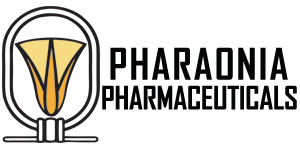

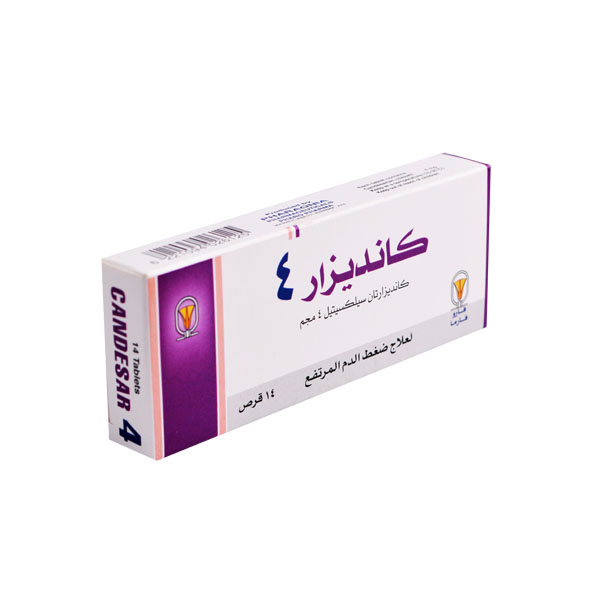
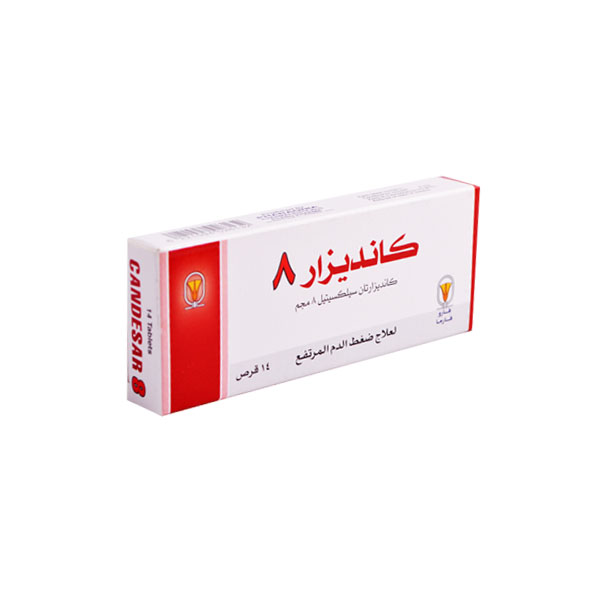
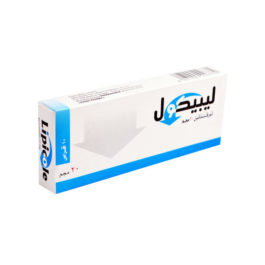

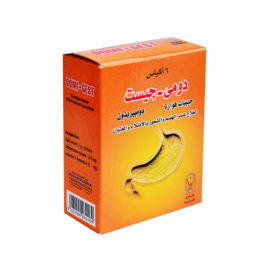
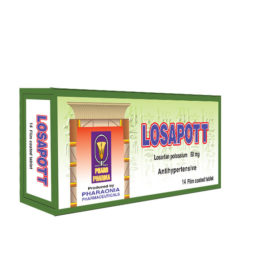
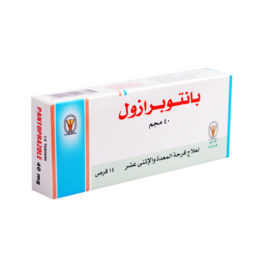
Reviews
There are no reviews yet.